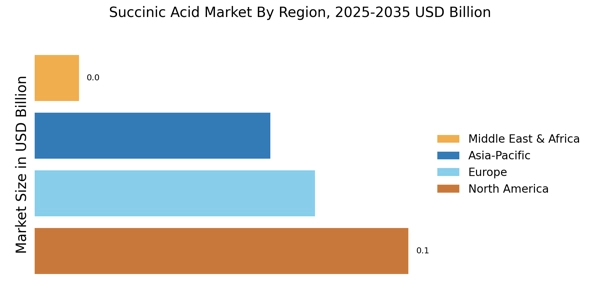Regulatory Support
Regulatory frameworks promoting the use of bio-based chemicals are likely to bolster the Succinic Acid Market. Governments worldwide are implementing policies that favor sustainable practices and the adoption of renewable resources. For instance, initiatives aimed at reducing greenhouse gas emissions and promoting bioeconomy are expected to create a favorable environment for succinic acid production. This regulatory support not only encourages existing manufacturers to expand their operations but also attracts new players to the market. As a result, the Succinic Acid Market is positioned to thrive, driven by favorable legislation that aligns with global sustainability goals.
Technological Innovations
Technological advancements in the production of succinic acid are likely to enhance the efficiency and cost-effectiveness of manufacturing processes within the Succinic Acid Market. Innovations such as fermentation technology and biocatalysis are being adopted to optimize yields and reduce production costs. For instance, recent developments indicate that fermentation processes can achieve yields of up to 90%, significantly improving the economic viability of succinic acid production. This technological evolution not only supports the growth of the market but also encourages new entrants to explore opportunities in this sector. As a result, the Succinic Acid Market is poised for expansion, driven by enhanced production methodologies that promise to meet rising demand.
Sustainability Initiatives
The increasing emphasis on sustainability appears to be a pivotal driver for the Succinic Acid Market. As industries strive to reduce their carbon footprints, succinic acid, derived from renewable resources, presents a viable alternative to petroleum-based chemicals. This shift is evidenced by the growing demand for bio-based products, which is projected to reach a market size of approximately 1.5 billion USD by 2026. Companies are increasingly investing in sustainable practices, which not only align with regulatory requirements but also cater to consumer preferences for eco-friendly products. The Succinic Acid Market is likely to benefit from this trend, as manufacturers seek to innovate and develop greener solutions that meet both environmental and economic goals.
Diverse Industrial Applications
The versatility of succinic acid in various industrial applications serves as a crucial driver for the Succinic Acid Market. It is utilized in sectors such as pharmaceuticals, food additives, and biodegradable plastics, which are experiencing robust growth. For example, the demand for biodegradable plastics is projected to grow at a CAGR of 15% over the next five years, creating substantial opportunities for succinic acid as a key ingredient. This broad applicability not only diversifies the market but also mitigates risks associated with reliance on a single sector. Consequently, the Succinic Acid Market is likely to see sustained growth as it caters to the evolving needs of multiple industries.
Rising Consumer Demand for Eco-Friendly Products
The growing consumer preference for eco-friendly products is emerging as a significant driver for the Succinic Acid Market. As awareness of environmental issues increases, consumers are actively seeking products that are sustainable and biodegradable. This trend is reflected in the rising sales of products containing succinic acid, particularly in the personal care and cosmetics sectors, where natural ingredients are highly valued. Market Research Future indicates that the demand for eco-friendly personal care products is expected to grow at a CAGR of 10% over the next five years. Consequently, the Succinic Acid Market is likely to experience growth as manufacturers respond to this shift in consumer behavior by incorporating succinic acid into their formulations.


















Leave a Comment